Best bike lights 2024 daytime-running and high-powered lights reviewed
The best bike lights rated, including how much to pay, the features you need, and our pick of the best bike lights on the market


Best Bike Lights 2023: Jump Menu
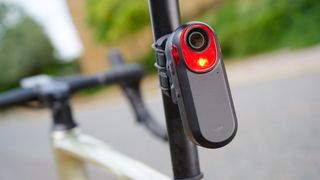
Front Lights
1. Best overall
2. Best for performance
3. Best for commuting
Rear Lights
1. Best overall
2. Best viewing angles
3. Best value
The best bike lights are essential if you're planning to ride after dark, before daybreak or even if you're out in poor conditions during the day.
Most cyclists will regularly ride after dark in autumn and winter, making bike lights an essential piece of kit, although daytime running bike lights are growing in popularity because they help you to be seen out on the road, even in bright sunlight.
We've tested a variety lights across a range of conditions, taking in to account a number considerations, including brightness, battery life, and build quality. From here we've selected the standouts and split our guide into three categories: front lights, rear lights and light sets.
Below that you’ll find all the details on our recent four-way grouptest, covering a selection of top-flight high-powered front lights. At the bottom of the page, we delve into all the techy details of what to look for in the best bike lights.
The Quick List
Front lights
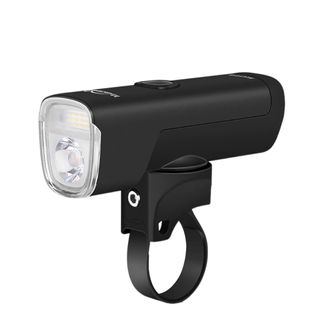
Best front bike light overall
At less than four times the price of the Exposure Strada MK12 RS AKTIV, the Magicshine ALLTY1000 provides a brighter central beam and longer battery life - all in a much lighter and more compact package. It misses out on the tech-y features of the Exposure, but for its combination of performance and price - the Magicshine ALLTY1000 is the light we'd recommend for most people.

Best front bike light for performance
Exposure has a strong repution for the build quality of its lights, and cool aluminium body of the Exposure Strada MK12 RS AKTiv just exudes quality. The beam is bright and the lens provides great side illumination - the light has lumens to play with after all. It's packed with neat tech and has a rear display which gives the battery life remaining down to the minute.
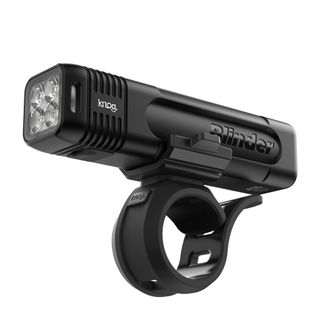
Best front bike light for commuting
The Knog Blinder, despite its name, is literally out-shone by the Magicshine and Exposure lights to its left. However, the Knog Blinder's beam is still perfectly bright enough for riding at an endurance pace down unlit roads - just not bombing it at threshold. The simple silicone band makes it super easy to mount and, for regular commuting duties, it makes an excellent option.
Rear lights
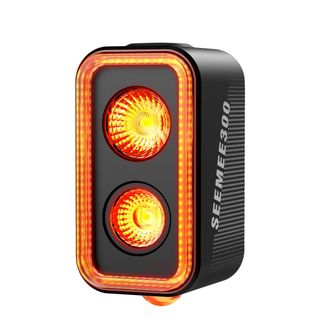
Best rear light overall
Tech-packed, boasting incredible battery life - and all whilst being competitively priced, the Magicshine SEEMEE300 is our overall winner. It has an in-built accelerometer and brightens when you brake, it castes a beam onto the floor to deliver 360 degree visibility and the battery life is claimed at an incredible 40 hours when shining at 20 lumens.

Best rear light for viewing angles
The two big pluses for the Knog Mid Cobber rear bike light are the 330 degree visibility from the main light body, giving exceptional viewing angles with a super bright 170 lumen flash. The cableless charging either cinches the deal or turns you off - there’s quite a split on that. It’s the most expensive but does have those USPs, if that matters to you.

Best value rear light
The Topeak Taillux doesn’t pack fancy features such as ambient light detection or an in-built accelerometer. But it does have a good range of light modes, from a 100 lumen flash to an eye-catching combo of a constant beam with a flashing parameter - on that consistent/flashing mode the battery life is a respectable 10 hours. It’s a solid performer and with the lowest price, it’s the best value on test.
Best bike lights 2024
You can trust Cycling Weekly.
Best front bike lights
The best front bike light overall
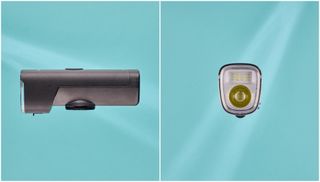
Magicshine's ALLTY1000 combines a bright beam with impressive battery life
1. Magicshine ALLTY1000 front light
Our expert review:
Specifications
Reasons to buy
Reasons to avoid
This light is really the star performer on test - it’s the least expensive by quite a way, super bright and nicely designed.
Let’s stick with the beam and lumens to start. I found it to be clearly brighter, casts its beam further, and has a similar beam width to the Trek Commuter Pro RT - and that’s despite both lights being claimed at 1,000 lumens and Trek’s light being over twice the price. By extension, the Magicshine Allty1000 is also brighter than both the PDW Lars Rover Power and the Knog Blinder 900.
There’s an interesting battle between which is brightest out of the Magicshine Allty1000 and the Exposure Strada Mk11 RS. I found that the central part of the Magicshine’s beam does shine brighter, but the Exposure Strada casts much more light to the sides, lighting up a greater area in total - as it should, with a lumen count of 1,450. Then again, the Exposure Strada costs over four times as much as the Allty1000, so in terms of light per penny, the Magicshine has the edge.





The Magicshine Allty1000 also has the longest battery life when shining on full. On the downside, it does charge with Micro USB rather than USB-C. The battery indication is more basic than the previous two lights, with a simple green LED changing to red and starting to flash as you get to 30% and 10% charge, respectively, which isn’t so helpful for power management on longer rides.
The band clamp system for the mount is really neat in how it accommodates all handlebar diameters without the need for rubber shims - which seem to invariably get lost. But the need for an Allen key and its fiddly nature means that this isn’t so easy to swap between bikes. On the other hand, it uses the same quarter-turn mount as a Garmin, so can be popped onto one of those mounts which is neat.
With the super bright beam for a light which is nominally only 1,000 lumens, I was perfectly happy putting in hard efforts when riding on the darkest roads with this light. I was able to see far enough ahead and with enough detail to push up to Threshold / Zone 4 and even seated VO2 Max / Zone 5 efforts. The only question is whether the performance at this price is too good to be true - I’d hesitate to give it full marks until the Allty1000 has proved itself in a full season of riding through the cold, wind and rain.
The best front bike light for performance

Exposure Strada MK12 RS AKTiv is both powerful and expensive
2. Exposure Strada MK12 RS AKTiv
Our expert review:
Specifications
Reasons to buy
Reasons to avoid
As expected, with its 1,450 lumen claimed output, the Exposure Strada certainly puts out a great deal of light - though it’s not the unambiguous winner in this regard. Despite being less than a quarter of the price, I found that the Magicshine’s Allty1000 offers up a brighter central beam than even the Exposure Strada can muster.
As mentioned earlier, this is largely down to the Exposure light spreading itself more thinly, lighting up the sides of the road to a greater extent. This side lumination isn’t going to be an important consideration for all riders, but I find a greater light spread can make for a less disorientating feeling when riding in the dark.
Exposure’s system for controlling the lights with the single, brushed metal button is very neat and well-thought out - but it does take a little while to get used to. Magicshine’s system is more basic, but it is at least intuitive straight out of the box.





It’s a similar thing for the bar clamp - Exposure’s split-clamp system is exquisitely designed, with two CNC machined pieces of metal slotting together to make the hinge and clamp. But it is rather more fiddly and harder to use than the simple - but effective - silicone strap of the Knog Blinder. The display on the rear of the Exposure Strada is a particularly neat feature of this light, displaying as it does the remaining charge of the light down to the minute.
Still, away from all the peripherals, fundamentally the Exposure Strada remains a really, really good light. Like the Magicshine, I was happy barrelling along through the dark at full tilt, with the road ahead of me reassuringly brightly lit.
This model comes with Exposure’s AKTiv tech, which automatically dims the light when faced with oncoming traffic. It’s really quite seamless, with the light smoothly reducing its brightness and equally smoothly returning to full strength - it’s not like switching between the main beam of your headlights and the dipped beam at all.
With the light so bright, it is quite nice and reassuring having it dip when faced with oncoming traffic - you can be quite sure that you won’t be dazzling anyone. Then again, if you aren’t running a MTB light with a whopping 3,000 lumens and if you do have your light correctly set up illuminating the road ahead of you, arguably this tech isn’t so necessary. Still, it functions well, is an extra nice-to-have, and solidifies this light as a tech-packed de-luxe model.
One of the most enduring features of Exposure lights, away from the excellent performance of the beams, is their longevity. Like Assos cycling kit, you are paying for a build quality which really lasts and should be considered alongside the (proportionality higher) upfront cost. However, against competition such as Magicshine’s Allty1000, it’s hard to recommend that everyone should spend that much more for Expsoure’s quality. But if you have the money to invest, you won’t be disappointed.
The best front light for commuting

The Blinder 900 is sound option for commuters
3. Knog Blinder 900 front bike light
Our expert review:
Specifications
Reasons to buy
Reasons to avoid
Despite having the weakest beam of all the lights on test, I really liked the Knog Blinder 900 and think there is good application for it. You just have to be clear about the sort of riding you’ll be using this light for. It’s simply not bright enough for bombing along at Tempo / Zone 3 through the still of the night - but it is plenty bright for riding at an Endurance / Zone 2 pace on even the darkest roads.
For a commuter light, rather than one for post-work training rides or long-distance winter epics, this is perfectly sufficient. When wearing casual clothes, I’m not really going to be pushing any harder than Zone 2. Plus, if your commute is mainly street lit, there’s simply no need for a brighter light than this as it doesn’t make a significant difference to what you can see.
With those parameters set out, the features really start to shine. First is the robust silicone band of the mounting bracket - I found this light is super easy to swap between bikes, taking a mere handful of seconds. There is still a quick release between the mount and the light, like all the other models on test - helpful when locking up in town.





Battery life is a handy two hours on full and the charging port is USB-C, so good future proofing there. There is a downside in that the battery indicator is as basic as the Magicshine Allty1000, with it remaining green for the most part and then changing to red at lower power percentages.
A little more expensive than the Magicshine Allty1000, for most people it would make more sense to both save money and go for the brighter light. Still, given how easy the Knog Blinder is to attach and detach, along with its USB-C charging port, I can see a commuter situation in which I actually would choose to spend the extra money and go with the less powerful Knog Blinder.
Admittedly, that is a pretty specific situation in which the Knog is the more desirable light, hence the four-star overall score.
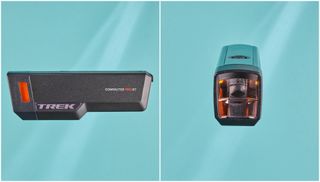
Trek's Commuter Pro RT front light is well-designed to maxmise the lumens available
4. Trek Commuter Pro RT front light
Our expert review:
Specifications
Reasons to buy
Reasons to avoid
More so than any of the lights on test, the lens of the Trek Commuter Pro RT is particularly well designed. It makes more effective use of the lumens it has available, focusing them from the area about two meters in front of your front wheel, and casting forwards from there.
It’s a really quite impressive light, and performs markedly better than the Knog Blinder (claimed 900 lumens) and also better than the PNW Lars Rover Power - though that light offers a claimed 850 lumens, so you would expect a fair difference between them anyway.
However, the comparison with Magicshine’s Allty1000 front light is rather less flattering, with the Allty1000 providing a more intense and clearer white light which is easier to see by - even though both lights have an equal claimed lumen count of 1,000. The Magicshine light is also less than half the price and has a longer claimed battery life on full, too.





Still, the Trek Commuter Pro RT does have a few neat features which could reasonably tip the balance for someone’s buying choice. I like the very clear and simple battery gauge, the fact that it charges with USB-C and the split clamp mounting system can be transferred between bikes without tools (although it isn’t as quick and easy as Knog’s system on the Blinder 900).
In use, the strength and pattern of the Commuter Pro RT’s beam meant that I was happy tapping along at Tempo / Zone 3 down unlit roads, although a solid Threshold / Zone 4 effort and seated VO2 Max intervals were a bit fast for the amount of road you can see ahead.
The two orange side lights are a neat touch for increasing side-on visibility at tricky junctions and roundabouts. No doubt it’s better having those extra lights than not having them, but with a winter jacket and bulky winter gloves, there’s quite a range of angles from which the lights will be obscured.
In all, the Trek Commuter Pro RT is a good light with lots of neat little features and functionality. It is also a fair chunk more expensive than other lights which outperform it in several key areas, meaning it’s not a first recommendation.
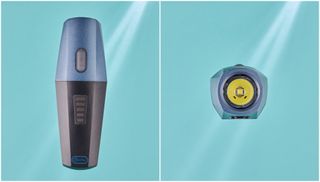
The Lars Rover is a robust front light
5. Portland Design Works Lars Rover Power 850
Our expert review:
Specifications
Reasons to buy
Reasons to avoid
Portland Design Works’ Lars Rover Power 850 is a solid light with some good features to it. But the competition is stiff and when there are better performers available for less - there’s only one way the recommendations are going to go. That said, if you come across a good discount, that could tip the balance in this light’s favour, depending on the level of performance you need from your lights.
Regarding the positives, the PDW Lars Rover Power comes in at two thirds of the price of Trek’s Commuter Pro RT and its battery gauge is equally clear and simple, providing a good sense of the amount of juice you have left. The mounting system is also a tool-less split-clamp, just like Trek’s, and I found swapping between bikes isn’t too much of a faff - though it is more involved than Knog’s excellent system on the Blinder 900.
On the downside, the beam is a little underpowered compared to the other lights on test. Still, despite being nominally only 850 lumens, it brightens the way better than the Knog Blinder and is arguably on a par with the Trek Commuter Pro RT - though PDW does have a very different beam pattern.





PDW’s Lars Rover Power extends its beam further than Trek’s Commuter Pro RT, but for me it doesn’t ‘fill’ the road ahead quite as well. The PNW light also doesn’t fill the area perpendicularly out from the front wheel, whereas the Commuter Pro RT does cast its light out in that direction, too. In essence, the Lars Rover Power is a more ‘basic’ lens, but depending on your application this light distribution could be preferable.
Still, despite having the lowest lumen count, the PDW Lars Rover Power also has the joint lowest claimed battery life out of all on test - equal with the Trek Commuter Pro RT. It also uses the Micro USB for charging rather than USB-C, it’s still reasonably expensive, and the aesthetics are quite outdated - noticeably so against the latest crop of front lights.
I found that I was happy riding on unlit roads at around an Endurance / Zone 2 level, also pushing up into the bottom end of Tempo / Zone 3. It didn’t provide enough light to push harder and ride faster than that, though. If you can find it on a discount, it’s a solid light for commuting, but at full RRP there are better options.
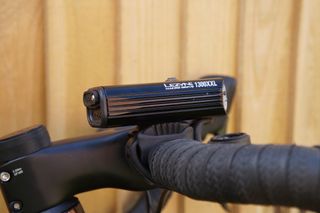
The Lezyne Macro Drive 1300XXL delivers a wide beam
Specifications
Reasons to buy
Reasons to avoid
The Lezyne Macro Drive 1300XXL, as its name suggests, puts out 1300 lumens. It provides a wide beam and attaches to the handlebar via a rubber strap, which is thick and stretchy, resulting in a robust overall package when paired with the CNCed aluminium body.
You can choose to use the 'Race' mode, which lets you switch between 1300 lumens and 130 lumens, or the standard mode, where you can cycle through all seven options. The Race mode is handy as it effectively lets you 'dip' the beam.
Charging is via a micro USB cable. The battery life is a claimed 2.5 hours. We tested this twice, and found we still had either a flashing red light (indicating 5% battery left) or solid red light (indicating 5-10% left) after 2 hours 20 minutes.
All in, we concluded that this is a solid light which we would wholeheartedly recommend.
Read more: Lezyne Macro Drive 1300XXL full review
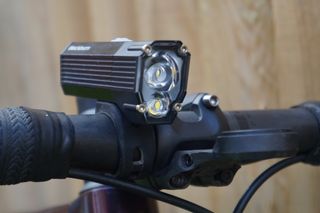
The Dayblazer offers plenty of power without a high price tag
Specifications
Reasons to buy
Reasons to avoid
The Dayblazer 1500 from Blackburn is the lowest scorer on test. It lost marks for the mount, which broke during our testing. We feel this was largely due to its skinny profile and the amount of force required to fit it to a chunky road bike handlebar - which we feel it needs to b able to withstand. In addition, whilst it claims to come with a helmet mount, we'd suggest it comes with a helmet mount adapter which doesn't provide all you'd need to fit the light to your lid.
Fittings aside, we found that the Blackburn Dayblazer 1500 does put out plenty of light. It was also the lightest option among those we tested, at just 143g. As for the build quality of the main body, it is robust, and water and grit protection is excellent.
Read more: Blackburn Dayblazer 1500 full review
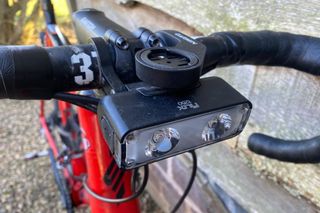
The Flux's lens shape makes for a wide angle beam
Specifications
Reasons to buy
Reasons to avoid
The Specialized Flux's robust aluminium construction and IP67 weatherproofing marks it out as a good all-condition option. There's a mix of spot and flood beams from the two LEDs and the light can be mounted on the bars, a helmet or via a GoPro mount.
There's a 3,400mAh battery that will give you 1.5 hours runtime on full power, with a choice of seven modes in total. We found that the flood beam really covers the width of the road and there is plenty of forward illumination. However, we also noted that this does limit the spot power when riding on trails for example.
Charging hasn't switched over to USB-C, although a full charge still takes only an hour.
Read more: Specialized Flux 1250 full review
Best rear bike lights
The best rear light overall
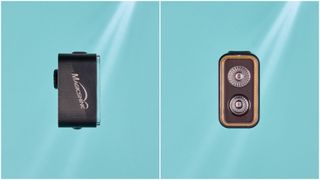
Magicshine's SEEMEE300 is packed with tech including an inbuilt motion sensor
1. Magicshine SEEMEE300
Our expert review:
Specifications
Reasons to buy
Reasons to avoid
The SEEMEE300 is an incredibly tech-packed light - as well as hitting a competitive price point. It’s really very impressive what Magicshine has done with this light, so let’s run through each of the features in turn.
First, the fun stuff. An increasing number of rear lights have these features, but Magicshine isn’t to be left out - the SEEMEE300 has an inbuilt motion sensor, with the light shining its full 300 lumens when it senses the bike is braking (the highest ‘constant’ setting is 100 lumens).
In addition to that, it also shines a circle of light onto the ground behind you, boosting visibility from every angle. The main light itself has a side cutout to increase the angle of visibility to 260 degrees - which is high in itself, although not the highest.
The mounting system is one the best I’ve ever used, with a thick silicone band that holds the light firmly in place (and on a variety of seatpost depths). But it also has a quarter turn mount, making it quick and easy to remove the light when wearing gloves in the winter - whether taking it in for charging, or when popping into the shops.
Then there’s the battery life, which is on another level. Even on the highest ‘constant’ setting, the claimed run time is six hours. When on the ‘low’ setting - which is still 20 lumens! - that goes out to a whopping 40 hours.
For me, there is one slight idiosyncrasy in that the light can sense the ambient light condition and adjust its beam accordingly - but the light goes brighter at night and dimmer during daylight. Personally, I’d want the brighter light in the daytime in order to stand out better - a light doesn’t have to be super bright to be highly visible at night. On the other hand, at least the daytime flash setting does make full use of all the 300 lumens.
In all, it’s a highly impressive light with a host of clever features and nice touches. The fact that the price is so competitive makes it the first choice in most cases.
The best rear light for viewing angles
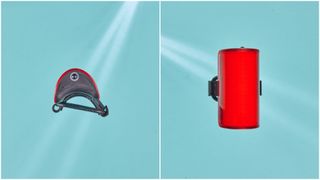
Th distinctive looking Knog Mid Cobber rear light
2. Knog Mid Cobber Rear Bike Light
Our expert review:
Specifications
Reasons to buy
Reasons to avoid
The Knog Mid Cobber has a few really nice features which make it stand out against the crowd - but it also has a few limitations which put it out of the running for ‘best overall’.
In terms of the good, the Knog Mid Cobber has the widest angle of visibility out of all the lights on test - the distinctive curve of this light is instantly recognisable as a Knog, and it gives a whopping 330 degree range of visibility directly from the light.
The Silicone O-ring is stretchy, strong, and can easily accommodate a range of seatpost depths. Being an O-ring, it’s hard (for me, impossible) to remove the light without removing your gloves first. But once you do it is quick to swap between bikes.
Finally, the Mid Cobber has built-in USB charging, so you don’t need to remember a cable - but you do need a USB port to plug it into and the light itself is pretty bulky. For some people cableless charging is a must-have deal breaker - for me, I prefer USB-C and the flexibility of a cable.
In terms of the not-so-good, the battery life isn’t great. The highest constant setting is 75 lumens (the full 170 only happens in some flashing modes) and this only lasts for 2 hours. Even the lowest constant setting at 35 lumens - which is still brighter than I think is necessary - is only 3.5 hours.
The flash settings do give you longer run times but, when riding at light, in many countries it’s a legal requirement to have at least one constant rear beam. And with good reason, it’s harder to track the motion of a vehicle/person when there isn’t a fixed source of light. So those short run times are a bit of a shame.
The price is also higher than the excellent Magicshine SEEMEE300, and with that light being so good in so many respects, most people will get better value from the cheaper option. But, if you like the wide visibility angle and the cableless charging, the Knog Mid Cobber could be an option for you.
The best value rear light
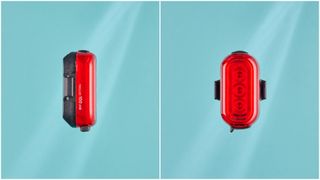
Topeak's Taillux 100 is a great value rear light
3. Topeak Taillux 100 USB
Our expert review:
Specifications
Reasons to buy
Reasons to avoid
The Topeak Taillux 100 doesn’t have the bells and whistles of some of the other lights on test - but it does the fundamentals very well, and comes in a little cheaper as a result.
The maximum brightness is 100 lumens and the burn time is listed as three hours on that mode, which is respectable, though not class-leading. In the arms race for ever more lumens, to have 100 on a rear light is pretty standard these days. But it is well beyond what is really necessary for being seen - during testing I never felt the need to run the light on full blast.
Fortunately, there is a mode which sees the three center lights stay constantly lit, but the bright outer ring blinks in a sequence. I really like this sort of setting, as you get the constant beam which makes it easier for people in cars to track your movement - but you also are more likely to catch their eye with the flickering light. Even better, this bumps the battery life up to a healthy 10 hours.
The mounting is via a Silicone band, which accommodates seatposts of varying depths, as well as making it easy to swap between bikes. You can also use the light with a clip, which makes it possible to attach to the light loop of a saddle bag or similar.
Charging is via USB-C which is nice and up to date. And the viewing angle is 220 degrees, which is respectable, although again not class leading. There are no features such as brake sensing or ambient light sensing. On the other hand, it’s light and a bit cheaper. If you don’t need the extra tech, this is a great option.
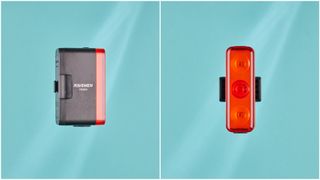
Raveman's TR500 excels as daytime running option
4. Ravemen TR500
Our expert review:
Specifications
Reasons to buy
Reasons to avoid
The Ravemen TR500 is a pretty close contender for being best on test. Starting with the best stuff, the ‘warning flash’ setting is exceptional for daytime riding. This chucks out a whopping 500 lumens with an eye-catching and rapid flash - if you’re concerned about riding at sunset, or are just after the maximum visibility at all times, this is an excellent option.
Like other lights on test, the maximum lumens for the constant beam are 100 and with a 4.5 hour runtime on that setting, it’s second only to the Magicshine SEEMEE300. But with 20 lumens of the ‘low’ setting are plenty, and on that setting you get a hefty 17 hours - again, second only to Magicshine.
Although it doesn’t have an ambient light sensor, the Ravemen TR500 light does have an accelerometer and I like how it brightens when you brake. The light attaches using a Silicone strap, which I found simple and straightforward to use, making it easy to swap between bikes and accommodate aero seatposts. The light also charges by USB-C.
Were it not for the Magicshine SEEMEE300 with its longer battery life - and also its floor-directed beam for full 360 degree visibility, the Ravemen would be top of this grouptest overall. But even so, that super-bright 500 lumen flash means that this is hands down the best daytime running light on test.

Bontrager's Flare RT is compact but still has plenty of features
5. Bontrager Flare RT
Our expert review:
Specifications
Reasons to buy
Reasons to avoid
This is a great little light with a solid range of features. Despite its diminutive size, it can still put out up to 90 lumens - although only on the flashing setting. With a constant beam, that brightest setting is 25 lumens and a run time of only 4.5 hours.
This goes out to 13.5 hours on the lowest light setting, but that only comes to five lumens - which is a little too dim for me! In a more urban setting, I don’t feel like that’s bright enough to really stand out against the street lights, traffic lights and the head and tail lights of passing traffic. On darker lanes without so much other light pollution, arguably those five lumens stand out better, but with the higher speed of traffic on country roads, I don’t feel like this is sufficient.
So the 4.5 hour run on ‘high’ is basically as good as it gets for night riding - but for commuting duties and evening rides, that is all that’s needed. The daytime flash mode is pretty good with those 90 lumens and a six hour run time, at least considering the size of the light.
And considering the size of the light is essentially what this all comes down to - either you want a smaller and less obtrusive light, and are happy to put up with less battery life as a result. Or the shorter battery life is going to be a sticking point and you’ll prefer something larger with more juice.
The attachment system is with a Silicone strap, but there’s also a quick-release lever, making it a bit quicker and easier to take the light off if you’ve stopped off somewhere or just need to take it in to charge. It’s not as easy as a quarter-turn mount - with gloves it’s a little fiddly but do-able. The charging is through micro USB, which is a little old-fashioned at this point, but with so many devices still using the standard, it’s not dead yet.
In all, this light suits someone who prizes size above all else. The brightness is perfectly serviceable for both daytime and nighttime use, it’s just the battery life is a little low and there isn’t much in the way of extra features - such as an accelerometer or visibility boosting from a range of angles. At the same price as the Ravemen TR500 and the Magicshine SEEMEE300 - as well as being more expensive than the Topeak Taillux 100 USB, it’s a pretty specific use-case where this one comes out top.

The ViZ300 is certainly bright but also a little fiddly to mount
Specifications
Reasons to buy
Reasons to avoid
Bright enough for all applications and a good choice of modes makes this a great choice for most serious riders. We particularly like how the ViZ300 has a 100 lumen mode lasting 8 hours, helping to make long winter rides that much safer. Alternatively, 45 hours on a single charge will keep most commuter users satisfied without charge for well over a week.
Three powerful LEDs make up the lighting array for this light. CatEye has incorporated good lensing and a nice clear case allowing for viewing angles of 300 degrees - so no blind spots for tailing drivers. Not that it comes on all too regularly, but the light also features a low battery light in the function button so you can see when a charge is needed.
Read more: CatEye ViZ300 rear light full review
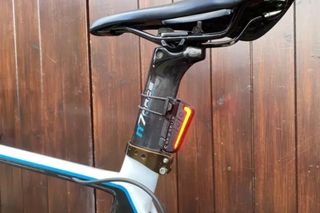
The Cerberus is designed to fit on any size or shape of seatpost
Specifications
Reasons to buy
Reasons to avoid
The Moon Cerberus is worth considering if you own a variety of bikes with different seat posts. The innovative hinged wings used to mount the light make it exceptionally versatile, though we'd also suggest that it might not be the most stable.
The light boasts three COB LEDs. A conventional rear-facing one is complemented by two lateral ones, ensuring that road users to your left and right also get a decent blast of light. It was this innovative set-up that achieved awards for the Cerberus soon after its launch.
Moon are known for their slick, compact lights and the Cerberus is no exception; the plush buttons aren't the easiest to locate and operate though. On the plus side, modes are well arranged and certainly not too plentiful; you won't be scrolling excessively to find what you need.
Read more: Moon Cerberus rear light full review

Specifications
Reasons to buy
Reasons to avoid
The Knog Blinder Square rear light is a really neat and smart light. It boasts 100 lumens of light and eight different programmes to suit your run-time and pattern preferences. The standard Blinder comes in a square, alien, cross or grid pattern further extending your flashy programme choices.
The small clasp makes it incredibly easy and secure to mount albeit with the downside of needing to swap bands for different sized seatposts. It uses a USB-A connector for charging doing away with the need for a cable and a vulnerable port but the battery indicator light itself is a bit hidden. There is also longer thinner Blinder V version available but we found the on/off switch harder to access than on the standard Square-shaped Blinder.
Read more: Knog Blinder Square and V Bolt rear light review
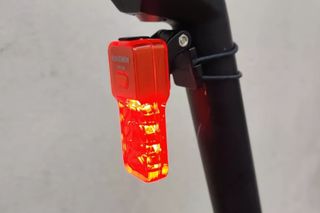
Specifications
Reasons to buy
Reasons to avoid
The main selling point for the Ravemen TR30M is the size and weight. The tiny 22 gram weight penalty is up there with the best of the smallest lights, whilst also boasting a respectable lumen count (30) and the 360 degree viewing angles.
However, you can’t have everything. The TR30M does fall down slightly on battery life compared to competitors in the 30 lumen vicinity. Plus, the mount isn't the most secure – likely due to the lightweight materials used.
That said, a quick charge time, 360 degree viewing angles and the lightweight formfactor still makes this a potential option for some riders.
Read more: Ravemen TR30M rear light full review

Garmin Varia RTL515 comes loaded with safety features
Specifications
Reasons to buy
Reasons to avoid
Garmin's Varia RTL515 has four light modes, 65-lumens under the hood, and has a viewing angle of up to 220-degrees, but that's not what sets this light apart.
Hidden inside this sleek looking taillight is a rear-facing radar which can pick up cars from up to 140m / 459ft away, and when connected to a Garmin, Wahoo or other brand head unit, alerts you to and tracks cars as they approach. It may sound like a gimmick, but in our experience, it is surprisingly accurate, and often picks up cars before our ears do.
The radar also means that the light can change its lighting pattern as a car approaches, flashing more brightly and more rapidly to make certain that you're seen.
There's a robust mount that can be converted to fit different shaped seatposts and an app to configure the light and which acts as a head unit if you don't have a bike computer.
Read more: Garmin Varia RTL515 review

Specifications
Reasons to buy
Reasons to avoid
The R300L is the first rear light and radar unit from Bryton. A built in G-Sensor can detect braking and change the light output accordingly, but it is the addition of radar that is the most interesting development.
The unit can detect vehicles from around 150m behind, alerting you with a bleep as well as a visual change to the side bar on your display, then, as the car approaches you, an icon moves up the side bar until it is near the top of the screen. Then you know that it is a short way behind you. Once the 'threat' has passed you or turned off, the unit bleeps again and the side bar turns green. Multiple vehicles can be displayed on your display too.
The great thing about this technology is how surprisingly useful it can become. You can concentrate on the road conditions more and then look down when it is appropriate to do so, having been alerted by the bleep. Then a look behind can be usefully deployed as necessary.
We found that the light is good, albeit not as great as the class leading lights, and it also has decent battery life. The light can be turned off completely, as it is able to be run solely as a radar unit, with a 24 hour battery life in that mode. The seat post bracket feels nicely secure and it locks the light on well, and conventional round, aero and D-shaped posts are catered for. It is priced very keenly for what it offers.
Read more: Bryton Gardia R300L Rear Light & Radar full review
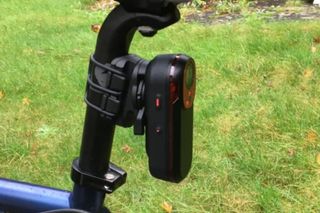
Specifications
Reasons to buy
Reasons to avoid
The Varia RCT715 is Garmin's range-topping integrated rear light, camera and radar unit – all in one. It's an incredibly versatile solution for covering your safety needs.
The rear-facing radar keeps you informed on the traffic situation behind, notifying you about cars from up to 140m / 459ft away. Our tester was surprised at how quickly he came to rely on its information and how just useful it proved.
The rear light itself has four modes, but it will also automatically change its behaviour when it senses a car approaching from behind and will change its flash pattern to further alert the driver. Our tester found the Day Flash 65 lumen setting best for daytime use and Solid 20 lumen mode for night riding.
On top of this, the camera films with a good quality at 1080p, which easily enables you to read the number plates of passing cars.
Read more: Garmin Varia RCT715 full review
Best bike light sets
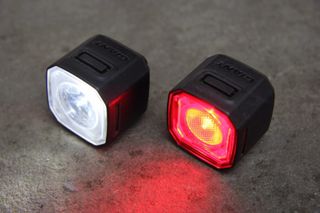
The Giant HL 100 and TL 100 Combo lightset is simple and easy to use
Specifications
Reasons to buy
Reasons to avoid
The Giant Recon HL 100 and TL 100 are very simple to operate, with no long presses, counting flashes to determine brightness level or anything like that. You just cycle through the five modes by short-pressing the on/off button and it’s the standard long press for on and off.
The switch, however, is a small oblong that needs direct pressure in exactly the right place. A protruding, rubbery switch would be easier but it would wreck the cube’s symmetry. I can live with form over function this time, but sometimes it takes a couple of attempts to activate it, especially with gloves.
The Tail-Light (TL) is surprisingly bright – blinding even – for such a small light. It’s really all you’d ever need from a rear light. The Head-Light (HL) is fine for streetlit commutes but is not enough for seeing on unlit roads – it is strictly a ‘be-seen’ light.
Landing in the middle ground price wise, they're well designed and have good functionality. Perfect for a lightweight, versatile, good-looking, commuter light set with a very useful daytime mode.
Read more: Giant Recon HL 100 and Recon TL 100 combo review

The Lezyne Micro Drive 600XL and KTV Pro light set is solid and secure
Specifications
Reasons to buy
Reasons to avoid
At 600 lumens, the Lezyne 600XL packs a punch and isn't far off being a 'seeing' light.
The front 600XL uses a permanently attached rubber strap to wrap it tight around the handlebar but it also rotates on the clamp allowing you to fit on fork leg or any odd angled position. Despite being used on the fork leg for riding LEJOG, we had no issues with the light remaining steadfastly in place.
The LEDs are arranged in a side-by-side pattern and push out a decent spread of light that in most modes works as a flood light to light up the road ahead evenly. Only in the two brightest modes does it take on more of a spot pattern, highlighting a smaller but brighter patch of the road ahead. But we can attest that even the lower flashing modes are bright enough to light up road signs from over five hundred metres away easily.
With regards the rear KTV unit, mounting is reliant on the thick rubber strap and slightly compliant rear recess on the light body. This recess is a little too narrow and the rubber a little too stiff to hold it tight against a standard seatpost. This does result in the light twisting off centre during a ride and reduces rear visibility. Something you will need to keep an eye on.
Read more: Lezyne Micro Drive 600XL and KTV Pro light set review

Exposure Trace lights are a long term favourite in the Cycling Weekly office
Specifications
Reasons to buy
Reasons to avoid
The Trace and TraceR lights are the smallest and most featherweight units Exposure produces and at first glance it's hard to imagine the sort of performance they are capable of. But just like David against Goliath, size isn't everything.
Tiny, robust, extremely bright and with long burn times, there really is nothing to fault the Exposure Trace and TraceR light set. Ideal for everything from commuting to being a backup set for longer trips, this is a set of lights that will provide reliable service for many a year.
The beam pattern and visibility for both lights are exceptional. The front throws out a good spread of light and in flashing mode easily lights up road signs for a few hundred metres ahead and the rear daybright mode is searingly bright. Both lights also have an extended lens that enables them to throw out a good level of side visibility, extending the safety levels.
Charging is simple and it takes just 1.5 hours to charge each from empty. A USB charging port is located under the rubber band that encircles the light. It can be a bit fiddly to pull it out of the way but you soon get used to the process. We’re yet to have any water ingress so despite its flimsy appearance it works really well.
Read more: Exposure Trace and TraceR MK2 light set review

CatEye Sync; Core and Kinetic light set uses wireless connection to pair lights together
Specifications
Reasons to buy
Reasons to avoid
The CatEye Sync range is the next step in bike lights where up to seven units are connected together wirelessly so that when one is switched on, the others light up too. Equally, when a mode is changed or the lights are to be turned off, one press of a button on one unit will change all the lights too.
It might sound a little excessive, but we found that it did genuinely make commuting easier – particularly with a train journey splitting up the riding and consequently having to turn the lights on and off twice as often.
The rear Kinetic light has an inbuilt accelerometer, which automatically turns on high mode when it detects a deceleration. This is very bright at 50 lumens and works very well to attract attention of road users behind.
The front light, which is 500 lumens, has extended side illumination for added 'be seen' credentials. It has five light modes and seems to be super bright during night time commuting. We were especially impressed by its quality build and the Daytime HyperConstant mode.
The Wearable is a nice addition too. It is a small light but still knocks out 40 lumens. Its shape lends itself to be seen from the side also and placed on the back, clipped to a pocket or bag, gives you some extra peace of mind that you'll be seen.
Read more: CatEye Sync; Core, Kinetic and Wearable review
Everything you need to know about bike lights
What should you look for in a bike light?
We’ll look at specialist lighting options in a moment, but for now, let’s assume you’re a road rider or commuter who wants to see and be seen when the sun sets. What do you need to consider when buying your lights?
Pretty much all modern cycle lights use LEDs rather than old-school bulbs, and such has been the advancement of technology, these can be blindingly bright.
Of course, light power is an important part of your buying criteria, but don’t let that be the be-all and end-all. Beam shape and the effect of the light lens can make a huge difference — we’ve seen lights of supposedly lesser power trounce rivals when it comes to real-world performance.
Even if you plan on using a light to see, it will still perform the double duty of helping you to be seen by other road users.
If you’ll be riding on lit roads, you may find the need for an ultra-bright constant beam is unnecessary and a flash function at the front is perfectly adequate.
What should I consider when choosing a rear light?
Though the amount of power you'll need for your front light will vary depending upon where you're riding, no cyclist should be without an adequate rear bike light. Rear bike lights will usually emit around 30 lumens or more, and generally have several modes: steady light, flashing, or a combination between the two. All options are safe and legal, but a flashing mode will usually help to save battery life and attract more attention.
Recently we have been introduced to the idea of using a rear bike light even in the daytime, because it will help drivers pick you out from behind. It's also a sensible idea to double up on rear lights. Though it's unlikely, you won't be quite so aware if your rear bike light fails as you would be in the case of a front beam, so having a back-up fitted can provide extra security and peace of mind.
For your rear light, the flash function is ideal. But if you’re a bike commuter, with both front and rear lights also consider how effective the lamp is in terms of side lighting, as this will make you more visible from more angles and help avoid the "sorry, I didn't see you" excuse from a turning vehicle.
It’s still generally a case of the brighter the better, but you also need to consider other qualities that will make your life easier. Look to see how many flash settings the light has; what the run times will be on a single charge or one set of batteries; and see if it has a rechargeable power source.
In this case, check if it needs its own special charger or if it can be recharged via USB, which aids convenience immensely. Some lights even have a helpful gauge showing how much power they have left.
What do the battery life numbers mean?
For most lights above we've quotes a battery life range. All lights will have multiple modes, so the range is from the most intense to the most economical option.
Most lights will burn through the battery quickly in their highest mode. For fast riding on tricky off-road trails you might need this, but it's worth dialling down the light intensity if you're on easier terrain or tarmac. Your eyes will quickly acclimatise to the lower light level, while on their top output many bike lights can be as intense as a car headlight and dazzle oncoming traffic.
Some lights will dial down their intensity if they start to get too hot or as the battery begins to run down and so extend battery runtime.
Flashing modes give you the longest battery life. They're a good option to up your visibility, particularly at the rear and when riding in daylight, but unless there's good street lighting you'll probably want to run a constant mode at the front at night, which will reduce runtime. It's why front lights usually have larger capacity batteries than rear ones.
It's worth looking at the quotes runtimes in different modes when selecting a light.
What does UK law say about bike lights?
New bikes are sold with reflectors (and you can read in detail about the legal requirements relating to reflectors here) but regardless - if you're riding at night, using a proper set of bike lights is really an essential.
In the UK, law regarding bike lights is governed by the Road Vehicles Lighting Regulations, first published in 1989 but amended six times since, which say that as well as your pedal reflectors and rear reflectors (the side and front reflectors aren’t actually a legal necessity) night-riders will also need lights front and back.
The lights have to be mounted on the bike centrally or to the offside, positioned up to 1.5m from the ground, and conform to British Safety or EC standards.
Both front or rear lights can be flashers, but if so they must emit at least four candela. “But bike lights tend to be rated in lumens or Watts, what’s a candela?” we hear you cry.
It’s not a particularly easy subject to explain, and they’re not directly convertible units. But simply put: as long as you buy decent quality bike lights, fit them properly, and remember to switch them on, the law shouldn’t be a problem.
Bike lights and the US law
What does US law say about bike lights?
In the US, the law requires riders to have both active and passive lighting — active lighting is well...lights, while passive lighting is things like reflectors and reflective clothing.
The exact wording of the laws varies from state to state, but the summation of it all is that between sunset and sunrise or in conditions of 'limited visibility' you must have a white light pointing forwards, and a red light pointing backwards.
What does the lumens number tell me about the power of my bike light?
Lumens are used by the bike industry to measure the power of a light: a lumen is a unit of visible light. Since modern LEDs require far less energy, expressing their power in watts — which tells you how much energy they consume rather than how much light they produce — is redundant. For comparison’s sake, a 100W incandescent bulb emits 1600 lumens.
The more you pay, the more lumens you get, but lumens burn up charge, meaning that if you want to run a high-lumen light for a long period of time it will need a big battery.
For road riding on unlit back streets, you need a 'seeing' light. This needs to be at least 700 lumens, though to ride fast like you would in the summer then 1000+ lumens is a safer bet as you'll have longer to anticipate obstacles like potholes.
To be seen when riding on lit roads, 100 lumens is a good benchmark, but 300+ will show you a little more of what's going on at ground level ahead of you. At the rear, anything from 20 to 100 lumens is plenty.
How should I mount my bike lights?
The last consideration is mounting. Smaller bike lights may be simply mounted using a rubber or silicone strap, whereas big lamps — especially front lights — may require a fixed bracket. Truly powerful front lights may even feature an external battery pack that will also need to be accommodated on the bike.
In any case, if you’re planning to leave your bike parked up in public for any length of time, make sure your lamps can be easily removed and take them with you when you stop.
Do I need back-up bike lights or helmet-mounted bike lights for extra brightness?
The typical bike commuter on urban streets will only need a relatively simple set of front and rear lights. There’s still every reason to buy the best you can afford, and even double up with an extra set of cheap emergency-only flashers front and back. But if you’ll be riding off-road or on unlit back roads, you really do need to go for the bigger, more powerful lamps with wider beams.
To augment their bike-mounted torch, many riders also opt for helmet-mounted lights. These can be very effective and have the added benefit of directing the light wherever you are looking. However, these should be in addition to those on the bike, and not your only source of illumination.
Another sensible option is the dynamo light. This uses a compatible hub or wheel-rubbing bottle dynamo to convert your forward motion into electricity which then powers the light — so no need for batteries. Bottle dynamos can be disengaged in daylight hours so they don’t drag unnecessarily, and at night mean you’ll never need to worry about run times or recharging again.

Super safe accessories
Night riding isn’t just about illumination. In recent years a whole industry of associated safety accessories has come about.
There are some smart options out there designed to improve your safety. For example, the Garmin Varia radars will literally make you aware of and track cars as they approach, while the CatEye Sync range allows you to switch on multiple lights at the push of one button.
There are more innovative products appearing all the time, so do enjoy exploring the world of cycle lighting. Just remember, the basic rules haven’t changed: be safe, be seen.
Get The Leadout Newsletter
The latest race content, interviews, features, reviews and expert buying guides, direct to your inbox!
Hannah is Cycling Weekly’s longest-serving tech writer, having started with the magazine back in 2011. She has covered all things technical for both print and digital over multiple seasons representing CW at spring Classics, and Grand Tours and all races in between.
Hannah was a successful road and track racer herself, competing in UCI races all over Europe as well as in China, Pakistan and New Zealand.
For fun, she's ridden LEJOG unaided, a lap of Majorca in a day, won a 24-hour mountain bike race and tackled famous mountain passes in the French Alps, Pyrenees, Dolomites and Himalayas.
She lives just outside the Peak District National Park near Manchester UK with her partner, daughter and a small but beautifully formed bike collection.
-
 Giro d'Italia 2024 start list: Geraint Thomas to lead "aggressive" Ineos Grenadiers
Giro d'Italia 2024 start list: Geraint Thomas to lead "aggressive" Ineos GrenadiersAll the teams and riders for the 107th Giro d'Italia
By Adam Becket Published
-
 Giant files lawsuit and recruits top Stages Cycling staff as power meter brand closes down
Giant files lawsuit and recruits top Stages Cycling staff as power meter brand closes downGiant filed a suit against Stages in February and four team members left the latter to join Giant
By Michelle Arthurs-Brennan Published